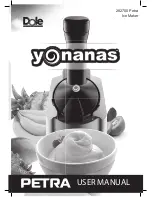
05
04
2.ESPRESSO EQUIPMENT
Parts in
an Elektra
espresso
machine
Boiler
This is a special sanitary copper
cylinder with an electric heating
element that heats the water to a
preset temperature. Because the
water is under pressure, the tem-
perature of the boiler water is
slightly higher than 100°C (boiling
point of water at sea level).
The boiler provides steam, boiling
water and also heats the water
passing through the heat
exchanger.
•
Group heads
A group head delivers hot water
under pressure to the ground cof-
fee held in a coffee handle locked
into the group head. Machines are
classed by the number of group
heads, with most commercial
machines having at least two.
The Elektra group heads has been
patented and is opened in two
parts.
•
Steam and hot water
Steam is used to froth milk and is
available through the steam
wand. Steam passes through the
wand when a valve is opened
manually, either by turning a tap or
operating a lever. Hot water is
available “on tap” through a hot
water outlet, again by manually
opening a valve.
The Elektra’s valves are complete-
ly made by Elektra.
•
Heat exchanger
•
Pump
•
Handles
•
Also a special sanitary copper
cylinder, the heat exchanger is
inside the boiler, and is partially
covered by the boiler water. As
cold water drawn from the mains
is passed through the heat
exchanger, it heats to the required
temperature before passing
through the coffee grounds. The
pressure to do this is provided by
the pump.
Driven by an electric controlled
motor, the pump pressurises the
water for entry into the boiler, and
also for passage through the heat
exchanger and the ground coffee,
which is held in a coffee handle.
The Elektra pump is made in a
special naval brass.
Coffee handles come in two basic
forms: single and double cup.
A filter basket containing the
ground coffee fits into the handle,
which then clips into a group head
so water from the heat exchanger
can pass through the grounds and
into one or two cups, depending
on the type of handle. The Elektra
handles are ergonomic and pro-
vided whit special bakelite handle.
These parts are in virtually all
espresso coffee machines.
Commercial machines also have
other facilities, like pushbutton
operation and flow sensors to
automatically measure the quantity
of water being dispensed for each
type of coffee drink.
Filter basket
•
This is a small perforated stainless
steel container to hold ground cof-
fee. A one cup basket has less
capacity and a slightly different
shape to a two cup basket.
(See photos next page).
2.ESPRESSO EQUIPMENT
Principles of an
espresso machine
Operating
principles
Most commercial espresso
machines work on the same
principle, although they can have
considerable differences in how
they achieve this. The diagram
below shows the hidraulic
diagram of an Elektra machine.
Water is heated in the boiler(
7
) to a
preset temperature with an electric
heating element(
24
).
Most machines maintain the boiler
water level automatically with
sensors(
25
) in the boiler that cause
a valve to open and thereby main-
tain the level as water is drawn off.
The water that passes through the
coffee grounds is heated in a heat
exchanger(
8
). This is simply a tube
surrounded by the boiler water,
and the machine settings ensure
the water passing through the
exchanger, and then through the
grounds is at 98°C. The pump pro-
vides pressure for both filling the
boiler, and to force heated water
through the coffee grounds.
Steam and boiling water are pro-
vided by the boiler, available
through outlets controlled by
manually operated valves.
These are either lever operated
valves, or taps turned with a knob.
Most commercial espresso
machines have electronic control
circuits to ensure correct water
temperature and boiler level.
Some also automatically control
the amount of water dispensed
into a cup for each type
of coffee drink.
11
12
16
17
14
15
2
3
5
7
8
6
10
9
18
20
13
19
4
1
21
22
23
24
25
Hydraulic diagram
water supply
water softener
entry water connect
motor/pump
one way valve
inlet sol. valve
boiler
heat exchanger
safety valve
va valve
filter
gigleur orefice
steam valve
hot water valve
expansion valve
gauge
group solenoid valve
coffee delivery group
filter
water flow meter
filter holder
hot water
cold water
electric heating element
sensors
Basic construction
of an Elektra espresso coffee machine.
1.
2.
3.
4.
5.
6.
7.
8.
9.
10.
11.
12.
13.
14.
15.
16.
17.
18.
19.
20.
21.
22.
23.
24.
25.


































